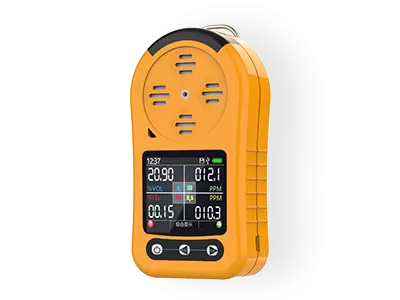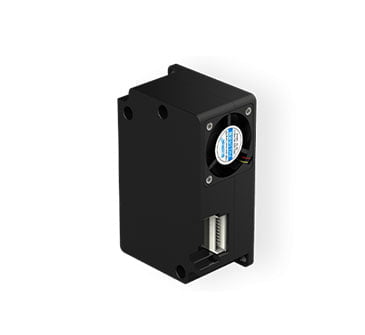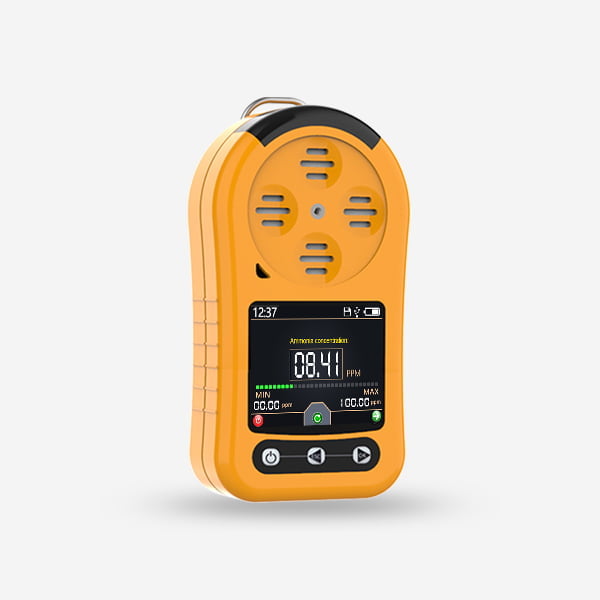A gas detector is a device that is detect the presence of gases in the air. It works by measuring the concentration of a gas in the surrounding environment and alerting the user if the levels exceed a certain threshold.

There are several types of gas detectors, each designed to detect different types of gases.
types of gas detectors :
FIXED GAS DETECTOR
Fixed gas detectors, also known as detectors, are permanently at specific locations within facilities to continuously monitor the presence of hazardous gases. We use these detectors in industrial plants, refineries and chemical facilities to continuously monitor gas levels that may leak. Fixed gas detector are available in several configurations, including point-type detectors, open-path detectors, and area monitoring systems.
Working principle of fixed gas detector

The working principle of a fixed gas detector involves the following steps:
Gas Sensing Element: The fixed gas detector contains a gas sensing element that is specifically detect the target gas. The most common types of gas sensing elements include electrochemical sensors, infrared sensors, and catalytic sensors.
Gas Sampling: The detector continuously samples the surrounding air for the presence of the target gas. The gas sensing element reacts with the target gas and produces a measurable signal.
Signal Processing: The detector processes the signal generated by the gas sensing element and converts it into a readable gas concentration value. This value is typically display on a digital screen or indicator lights on the detector.
Alarm Activation: If the gas concentration exceeds the set value, the fixed gas detector will sound an alarm to alert the user. The alarm can be a loud sound, flashing light, or a remote notification.
PORTABLE GAS DETECTOR

Portable gas detectors are handheld or wearable devices designed for on-the-go gas detection and personal safety monitoring. These compact and lightweight detectors are widely use in industrial maintenance, confine space entry, emergency response, environmental monitoring. Portable gas detector are available multi-gas configurations, offering flexibility and mobility for personnel working in diverse environments.
Working principle of Portable gas detector
The working principle of a portable gas detector is similar to that of a stationary gas detector, there are some key differences in portability. Here is an overview of the working principle of a portable gas detector:
- Gas Sensing Element: Portable gas detectors have gas sensing elements that specifically detect the target gas. Common types of gas sensing elements used in portable detectors include electrochemical sensors, infrared sensors, and catalytic sensors.
- Gas Sampling: Portable gas detectors continuously sample the surrounding air for the presence of the target gas. The gas sensing element reacts with the target gas and produces a measurable signal.
- Signal Processing: The detector processes the signal generated by the gas sensor and converts it into a readable gas concentration value. This value is usually displayed on a digital screen and the user monitors the gas level in real time.
- Alarm Activation:The portable gas detector also has an alarm system that activates when the gas concentration exceeds a preset threshold. The alarm can be in the form of an audible alarm, a visual alarm (such as a flash), or a vibration alarm to alert the user to a potential danger.
MULTI-GAS DETECTORS

Multi-gas detectors are advanced devices monitor multiple gases simultaneously in industrial and environmental . These detectors are equip with multiple gas sensors that can detect a wide range of gases, providing comprehensive monitoring and ensuring the safety of personnel working in hazardous environments.
Working principle of Multi gas detector
The working principle of multi-gas detectors involves several key components and technologies that enable them to accurately detect a wide range of gases.

- Gas Sensors: Multi-gas detectors are equipped with multiple gas sensors that are designed to detect specific gases or gas groups. These sensors utilize various technologies, such as electrochemical, catalytic,, to detect the presence of gases based on chemical properties. Each sensor is sensitive to a particular gas or group of gases and provides a signal when the gas concentration exceeds a certain threshold.
- Sampling System: The multi-gas detector has a sampling system that takes a sample of air from the surrounding environment for analysis. The sampling system ensures constant air flow to the sensor. By continuously sampling the air, the sensor can monitor the gas concentration in real time, providing immediate feedback.
- Data Processing: Once the gas sensors detect the presence of gases in the air, the detector’s internal processor analyzes the sensor data . The processor compares the measured gas concentrations to preset alarm levels and triggers visual. Some detectors also have data logging capabilities to record gas concentrations over time for later analysis.
- Display and Alarms: Multi-gas detectors are equipp with a display screen that shows real-time gas concentrations, alarm status, . The display provides visual feedback to the user, allowing them to monitor gas levels and take appropriate actions if necessary. In addition to the display, multi-gas detectors have built-in audible and visual alarms that alert the user when gas concentrations reach dangerous levels.
In summary, gas detectors include the use of advanced sensors, data processing and alarm systems to monitor and detect the presence of multiple gases in the environment. By providing real-time gas monitoring and alarm capabilities, gas detectors help keep workers safe in hazardous environments . Regular calibration is essential to maintain the accuracy and effectiveness of detector inspection.





